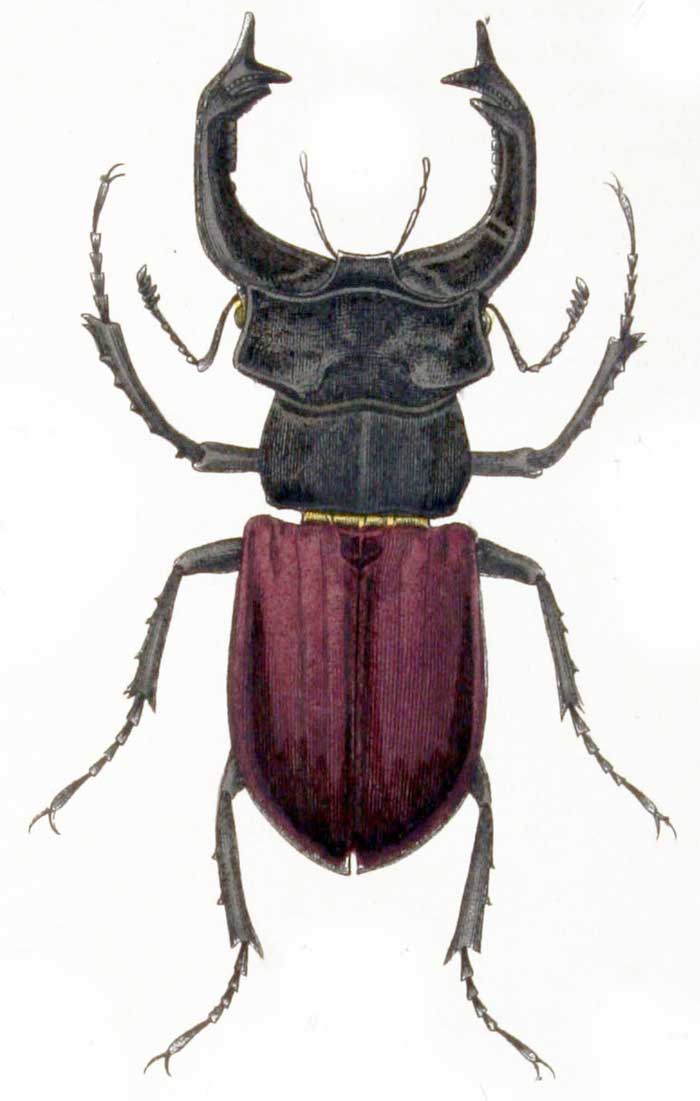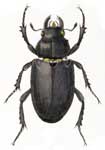Superregnum: Eukaryota
Cladus: Unikonta
Cladus: Opisthokonta
Cladus: Holozoa
Regnum: Animalia
Subregnum: Eumetazoa
Cladus: Bilateria
Cladus: Nephrozoa
Cladus: Protostomia
Cladus: Ecdysozoa
Cladus: Panarthropoda
Phylum: Arthropoda
Subphylum: Hexapoda
Classis: Insecta
Cladus: Dicondylia
Subclassis: Pterygota
Cladus: Metapterygota
Infraclassis: Neoptera
Cladus: Eumetabola
Cladus: Endopterygota
Superordo: Coleopterida
Ordo: Coleoptera
Subordo: Polyphaga
Infraordo: Scarabaeiformia
Superfamilia: Scarabaeoidea
Familia: Lucanidae
Subfamilia: Lucaninae
Tribus: Lucanini
Genus: Lucanus
Subgenus: Lucanus (Lucanus)
Species: Lucanus cervus
Name
Lucanus cervus (Linnaeus, 1758)
Original combination: Scarabaeus cervus
Synonyms
?Scarabaeus tridentatus Linnaeus, 1758 (in part)
Scarabaeus capreolus Füessly, 1775
Scarabaeus dorcas Müller, 1776
Scarabaeus capra Olivier, 1789
Scarabaeus hircus Herbst, 1790
Scarabaeus inermis Marsham, 1802
Scarabaeus grandis Haworth, 1807
Scarabaeus microcephalus Mulsant, 1842
Scarabaeus lusitanicus Hope et Westwood, 1845
Scarabaeus maxillaris Motschulsky, 1845
Scarabaeus vicinus Hope et Westwood, 1845
Scarabaeus cornutus Dale, 1893
Scarabaeus judaicus Planet, 1902
Scarabaeus validus Möllenkamp, 1912
References
Linnaeus, C. 1758. Systema Naturae per regna tria naturæ, secundum classes, ordines, genera, species, cum characteribus, differentiis, synonymis, locis, Tomus I. Editio decima, reformata. Holmiæ: impensis direct. Laurentii Salvii. i–ii, 1–824 pp DOI: 10.5962/bhl.title.542: 353. Reference page.
Fabricius, J.C. 1775: Systema Entomologiae, sistens insectorum classes, ordines, genera, species... Flensburgh and Leipzig, Library Kortii. Internet Archive Biodiversity Heritage Library
Links
Stag-beetle Lucanus cervus (Linnaeus, 1758) in nature
Stag beetle
Lucanus cervus – Taxon details on Animal Diversity Web (ADW).
Lucanus cervus – Taxon details on Biological Library (BioLib).
Lucanus cervus – Taxon details on Encyclopedia of Life (EOL).
Lucanus cervus – Taxon details on EPPO code.
Lucanus cervus – Taxon details on Fauna Europaea.
Lucanus cervus – Taxon details on Fossilworks.
Lucanus cervus – Taxon details on Global Biodiversity Information Facility (GBIF).
Lucanus cervus - Taxon details on iNaturalist.
Lucanus cervus – Taxon details on Interim Register of Marine and Non-marine Genera (IRMNG).
Lucanus cervus – Taxon details on National Biodiversity Network (NBN).
Lucanus cervus – Taxon details on National Center for Biotechnology Information (NCBI).
Lucanus cervus - Taxon details on Red Data Book of Russia
Lucanus cervus – Taxon details on Inventaire National du Patrimoine Naturel (INPN).
Lucanus cervus – Taxon details on Universal Biological Indexer and Organizer (uBio).
Vernacular names
asturianu: Vacalloria
Boarisch: Hirschkäfer
беларуская: Жук-алень
български: Бръмбар рогач
brezhoneg: C'hwil-kornek
català: Escanyapolls
čeština: Roháč obecný
dansk: Eghjort
Deutsch: Hirschkäfer
English: Stag beetle
Esperanto: Cervoskarabo
español: Ciervo volante
eesti: Põderpõrnikas
فارسی: شاخگوزنی لوکانوس کروس
suomi: Tamminkainen
français: Lucane cerf-volant
furlan: Cierf volant
galego: Escornabois
עברית: איילית
hrvatski: Obični jelenak
magyar: Nagy szarvasbogár
Ido: Lukano
italiano: Cervo volante
日本語: ヨーロッパミヤマクワガタ
ქართული: ირემახოჭო
қазақша: Бұғы қоңыз
lietuvių: Paprastasis elniavabalis
latviešu: Dižā briežvabole
Nederlands: Vliegend hert
norsk: Eikehjort
polski: jelonek rogacz
português: Vacaloura
русский: Жук-олень
slovenčina: Roháč veľký
slovenščina: Rogač
shqip: Kacadreni
српски / srpski: Јеленак
svenska: Ekoxe
татарча/tatarça: Болан коңгыз
українська: Жук-олень
Lucanus cervus, the European stag beetle, is one of the best-known species of stag beetle (family Lucanidae) in Western Europe, and is the eponymous example of the genus. L. cervus is listed as Near Threatened by the IUCN Red List.[1]
Taxonomy
Lucanus cervus is situated in the genus Lucanus within the family Lucanidae. In the genus there are two subgenera: Lucanus Scopoli, 1763 and Pseudolucanus Hope and Westwood, 1845.[3] The species L. cervus contains four subspecies. The nominate subspecies L. cervus cervus (Linnaeus, 1758) was established via the original description of the species in 1758. The three latterly added subspecies are L. cervus judaicus Planet, 1900, L. cervus laticornis Deyrolle, 1864, and L. cervus turcicus Sturm, 1843.[2] L. cervus akbesianus 1896
Description
Sexual dimorphism - male and female
Sexually dimorphic, the males have enlarged mandibles and are larger than the females. Although the male's mandibles seem threatening, they are too weak to be harmful. Nevertheless, females can inflict a painful bite. The resemblance of the male's mandibles to the antlers of a stag, and their use in combat between males, much like with deer, gives the species its scientific and common names.
Adult size varies between different areas of its distribution, for example beetles from Spain, Germany, and the Netherlands are larger than those from Belgium or the UK.[4]
Distribution and habitat
Lucanus cervus is widespread across Europe,[4] though it is absent from Ireland.[1] In Germany it is widespread, mainly in the south. In Hungary this species is widespread in the hilly and mountainous areas. In Romania it is widespread, especially in the hilly areas with sun exposed slopes. It also occurs in the European part of Turkey.[1] In Italy it is mainly distributed in northern and central regions.[5] In Spain and Portugal it is present only in the northern half of each country.[6][7] In Britain it is largely confined to the south-east of England, where it is widespread.[8] This species is now extinct in Denmark and Latvia.[9] It is also found in Caucasus, Asia Minor, Syria and west Kazakhstan.[1] Its range is currently only increasing in Croatia and Slovakia.[4]
Lucanus cervus has been associated with a range of trees including those in the families oak (Quercus), lime (Tilia), beech (Fagus), willow (Salix) and certain species in other families including black poplar (Populus nigra), ash (Fraxinus excelsior), horse-chestnut (Aesculus hippocastanum), wild cherry (Prunus avium), and common walnut (Juglans regia).[10] Larval development sites were found in proximity of dead wood of the allochthonous Quercus rubra.[11]
Lifecycle
Lifecycle stages of L. Cervus
Adults appear during late May to the beginning of August, being most active in the evenings. Females lay their eggs in a piece of decaying wood deep in the soil. Stag beetle larvae, which are blind and shaped like a letter "C", feed on rotting wood in a variety of places, tree stumps, old trees and shrubs, rotting fence posts, compost heaps, and leaf mould. The larvae have a cream-coloured, soft, transparent body with six orange legs, and an orange head which is very distinct from the very sharp brown pincers. They have combs in their legs which they use for communication (stridulation) with other larvae. The larvae go through several instars (stages),[12] taking 1 to 3 years to become pupae.
Mature larva
Male pupa; the distinctive mandibles are clearly visible
The work of entomologist Charlie Morgan during the late 1970s discovered that the pupae of the stag beetle live in the soil for about 3 months, then emerge in summer to awkwardly fly off to mate. Adults only live for a few weeks, feeding on nectar and tree sap. Their slow, lumbering flight, usually at dusk, makes a distinctive low-pitched buzzing sound. The males fly more readily than the females.
Behaviour and ecology
The natural reaction of the beetle to an approaching large object is to remain motionless, making them a good photographic subject.
Daily activity, use of space and detectability
In a primary ancient forest in northern Italy, stag beetle males were less elusive than females. Males were more frequently radio-tracked in flight, females mostly underground and in the proximity of deadwood. Males were mostly observed flying at sunset, and resting or walking on standing trees during the day. The combination of air temperature and humidity determined the optimal weather conditions for male flights. Flying at sunset, mostly performed by males, significantly increased the detectability of the species. [13] Stag beetles are shown to be more active during the first part of their adult lives. Males were more prone to disperse than females but the home range size did not differ between the sexes. Dividing the flight season in three intervals, the most active individuals were recorded during the first and the second ones (first and second half of June).[14]
Predators
Natural predators of L. cervus in Britain include cats, foxes, carrion crows, magpies and kestrels; these tend to strike at the most vulnerable stage in the beetle’s life cycle, when adults are seeking to mate and lay eggs.[9] In the case of magpies, they have been observed in the field as waiting for emergence on a single site; subsequently consuming the beetle's abdomen.[15]
In Italy, the main predator is the Hooded crow (Corvus cornix).[16]
Parasites
Mites in the order Monogynaspida (Suborder Uropodina) are phoretic (attached for the purpose of transportation) and have been observed attached to L. cervus as deutonymphs on the membrane of the joint between head and pronotum.[17]
Relationship to humans
Protection
Lucanus cervus is listed as Near Threatened by the IUCN Red List.[1] Although this species is widely distributed in Europe, it is in significant decline in the north and central part of its range and future trends of European forests will pose serious threats to this species, thus making the species close to qualifying for Vulnerable.[1]
Lucanus cervus is registered in the second appendix of the Habitats Directive of the European Union from 1992, which requires that member states set aside special areas of conservation. The species is also registered in the third appendix of the Convention on the Conservation of European Wildlife and Natural Habitats (Berne convention) of 1982 and Schedule 5 of the UK's Wildlife and Countryside Act 1981.[12]
References
"Lucanus cervus". IUCN Red List of Threatened Species. 2017. 2017. Retrieved 2017-01-23.
"Stag Beetle, Lucanus cervus (Linnaeus, 1758)". BioLib.cz. Retrieved 2017-07-05.
"Genus:. Lucanus Scopoli, 1763". BioLib.cz. Retrieved 2017-07-05.
Harvey, D.J.; Gange, A.C.; James, C. J.; Rink, M (2011). "Bionomics and distribution of the stag beetle, Lucanus cervus (L.) across Europe". Insect Conservation and Diversity. 4: 23–38. doi:10.1111/j.1752-4598.2010.00107.x.
Bartolozzi L.; Maggini L. (2006). "Insecta Coleoptera Lucanidae". In S. Ruffo; F. Stoch (eds.). Checklist and distribution of the Italian fauna. Museo Civico di Storia Naturale di Verona. pp. 191–192.
López-Colón, J. I. (2000). "Familia Lucanidae". In Martín-Piera, F.; López-Colón, J. I. (eds.). Fauna Iberica Vol. 14: Coleoptera, Scarabaeoidea I. CSIC.
Grosso-Silva, J.M. (1999). "Contribuição para o conhecimento dos lucanídeos (Coleoptera, Lucanidae) de Portugal". Boletín de la Sociedad Entomológica Aragonesa (in Portuguese). 25: 11–15.
"Lucanus cervus (Linnaeus, 1758) [Stag Beetle]". National Biodiversity Network. Retrieved 2017-02-24.
"About stag beetles". People's Trust for Endangered Species. 2017. Retrieved 2017-02-24.
"Coleoptera >> Lucanidae >> Lucanus cervus (L.)". Database of Insects and their Food Plants (Biological Records Centre). Retrieved 2017-02-24.
Tini, M.; Bardiani, M.; Campanaro, A.; Mason, F.; Audisio, P.; Carpaneto G.M. (2017). "Detection of stag beetle oviposition sites by combining telemetry and emergence traps". Nature Conservation. 19: 81–96. doi:10.3897/natureconservation.19.12678.
"Lucanus cervus". Encyclopedia of life. Retrieved 2017-02-24.
Tini, M.; Bardiani, M.; Campanaro, A.; Chiari, S.; Mason, F.; Maurizi, E.; Toni, I.; Audisio, P.; Carpaneto, G.M. (2017). "A stag beetle's life: sex-related differences in daily activity and behaviour of Lucanus cervus (Coleoptera: Lucanidae)". Journal of Insect Conservation. 21: 897–906. doi:10.1007/s10841-017-0029-5.
Tini, M.; Bardiani, M.; Chiari, S.; Campanaro, A.; Maurizi, E.; Toni, I.; Mason, F.; Audisio, P.; Carpaneto, G.M. (2018). "Use of space and dispersal ability of a flagship saproxylic insect: a telemetric study of the stag beetle (Lucanus cervus) in a relict lowland forest". Insect Conservation and Diversity. 11: 116–129. doi:10.1111/icad.12260. hdl:11573/1070456.
Fremlin, m; Davidson, J.; Davidson, G. (2012). "Stag Beetle Predation by Magpies in a Colchester Garden" (PDF). Nature in North-East Essex: 81–85.
Campanaro, A.; Toni, I.; Hardersen, S.; Grasso, D. A. (2011). "Monitoring of Lucanus cervus by means of Remains of Predation (Coleoptera: Lucanidae)". Entomologia Generalis. 33 (1): 79–89. doi:10.1127/entom.gen/33/2011/79.
Hawes, C. (2010). "Hitchhiking a lift: Stag Beetles as Carriers of Mites" (PDF). White Admiral. 77: 16–17.
Retrieved from "http://en.wikipedia.org/"
All text is available under the terms of the GNU Free Documentation License




